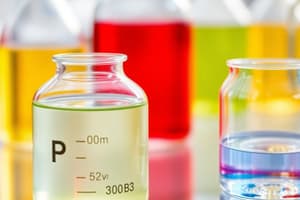Podcast
Questions and Answers
What is the range on the pH scale that is considered strongly acidic?
What is the range on the pH scale that is considered strongly acidic?
- 0-3 (correct)
- 7-10
- 4-6
- 11-14
Which of the following is NOT an Acid-Alkali Indicator?
Which of the following is NOT an Acid-Alkali Indicator?
- Red Cabbage
- Universal Indicator (correct)
- Natural Indicator
- Litmus paper
Which of the following is a common acid used in various applications?
Which of the following is a common acid used in various applications?
- Sodium hydroxide
- Ammonium hydroxide
- Sulphuric acid (correct)
- Hydrochloric acid
When does litmus paper turn blue?
When does litmus paper turn blue?
What is neutralization in chemistry?
What is neutralization in chemistry?
Which of the following is NOT a characteristic of the pH scale?
Which of the following is NOT a characteristic of the pH scale?
Which of the following acids is LEAST corrosive?
Which of the following acids is LEAST corrosive?
Which of the following alkalis is the STRONGEST?
Which of the following alkalis is the STRONGEST?
What is the primary purpose of using an acid-alkali indicator in a chemical reaction?
What is the primary purpose of using an acid-alkali indicator in a chemical reaction?
What is the primary product of the neutralization reaction between an acid and an alkali?
What is the primary product of the neutralization reaction between an acid and an alkali?
Study Notes
Acids and Alkalines
Acids and alkalines are essential components of chemistry, playing a vital role in various chemical reactions and biological processes. Understanding their properties, behaviors, and interactions is crucial for numerous applications across different fields. In this article, we delve into the intricacies of acids and alkalines, exploring the pH scale, indicators, common acids and alkalis, acid-alkali indicators, neutralization, and the corrosive nature of acids.
The pH Scale
The pH scale is a logarithmic measurement of the acidity or alkalinity of a solution. The scale runs from 0 to 14, with 7 being neutral. Solutions with a pH of 0 to 3 are considered strongly acidic, while those with a pH of 8 to 10 are weakly alkaline. Any solution outside these ranges is either highly acidic or highly alkaline.
Indicators
Indicators are chemicals that change color when added to acidic or alkaline solutions. These color changes help determine whether a solution is acidic, neutral, or alkaline. Some common indicators include litmus paper, phenolphthalein, and methyl orange. Litmus paper is purple in neutral solutions, turns red for acidic solutions, and blue for alkaline ones. Phenolphthalein is colorless in acidic solutions but turns pink in alkaline solutions. Methyl orange is orange in neutral solutions, turning red for acidic solutions and yellow for alkaline ones.
Common Acids
Common acids used in laboratories include hydrochloric acid (HCl), nitric acid (HNO3), sulfuric acid (H2SO4), and ethanoic acid (CH3COOH). These acids play significant roles in various industrial processes and laboratory experiments.
Common Alkalis
Common alkalis used in laboratories include sodium hydroxide (NaOH), potassium hydroxide (KOH), calcium hydroxide (Ca(OH)2), and ammonia (NH3). These alkalis have essential functions in chemical synthesis, catalysis, and other chemical reactions.
Acid-Alkali Indicators and the pH Scale
Indicators like litmus paper, phenolphthalein, and methyl orange follow the same principle of color change based on the pH scale. Their transitions occur around specific pH values, making them useful tools for approximating the pH of a solution without precise measurements. Additionally, universal indicator, a mixed indicator containing several color-changing substances, can provide a full range of colors along the pH scale, offering a broader estimation of a solution's pH.
Neutralization
Neutralization is a process involving adding an acid to an alkali (or vice versa) to create a neutral solution with a pH of 7. This reaction forms a salt and water. It helps balance the acidity and alkalinity of a solution, often seen during reactions between acids and bases.
Corrosive Nature of Acids
Acids have varying degrees of corrosivity, which can damage materials and cause health issues. Strong acids like hydrochloric and sulfuric acids are particularly corrosive due to their ability to dissolve metals and burn skin.
Understanding acids and alkalines is key to navigating the world of chemistry, from understanding chemical reactions to designing safe lab environments. By familiarizing yourself with the pH scale, indicators, common acids and alkalis, acid-alkali indicators, neutralization, and the corrosive nature of acids, you gain valuable insights into the fascinating realm of chemistry.
Studying That Suits You
Use AI to generate personalized quizzes and flashcards to suit your learning preferences.
Description
Explore the fundamental concepts of acids and alkalines, including the pH scale, indicators, common acids and alkalis, acid-alkali indicators, neutralization, and the corrosive nature of acids. Gain insights into their properties and roles in chemical reactions and biological processes.




